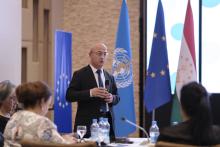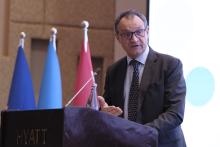Tajikistan has reformed its health system to prioritize primary health care, and today 86% of health facilities operate under the family medicine model. A more resilient and equitable healthcare system paves the way for UHC and improved health outcomes.
Bringing healthcare closer to communities and ensuring that essential services are accessible, affordable, and tailored to the needs of the population improves health, saves lives, and leads to measurable progress towards UHC.
Significant reductions in maternal and infant mortality rates and in the prevalence of diseases are a result of Tajikistan’s investments in PHC to improve the infrastructure and capacity of the healthcare system.
The Government of the Republic of Tajikistan, with support from WHO through the UHC Partnership, reformed its health system and increased the public health budget allocated to PHC from 34.6% in 2010 to 40.7% in 2022. It invested in PHC infrastructure, human resources for health, and financial protection for the population, which led to a significant decrease in maternal and child mortality.

“In 1989, when I began my career as a nurse, home births were common, and pregnant women rarely registered at health facilities. There was a high mortality rate among women and children."
“I came to Rudaki District Centre to see my doctor. The doctor helped me. They have all the necessary facilities.”
“Today, it has become easier for all medical workers in the district polyclinic. They do not have to go to Dushanbe to attend advanced training courses and new seminars.”

"The funding for primary health care has increased tenfold. 80% of primary health care facilities are now equipped with modern medical equipment. As a result, the maternal and child mortality rate and the number of infectious and non-infectious diseases have decreased nationwide."

“Over the past decades, Tajikistan has made great strides to make essential healthcare and services more accessible to the population. WHO will continue to support Tajikistan to prioritize primary health care as this is a fundamental necessity for building resilient and equitable societies."
THE LONG READ
Rafoat Sanginova is a family nurse and over her 34-year career she has witnessed huge improvements in people’s health.
“In 1989, when I began my career as a nurse, home births were common, and pregnant women rarely registered at health facilities. There was a high mortality rate among women and children," recalls Rafoat.
Today, much has changed as Tajikistan has oriented its health strategy towards a PHC approach, bringing health care closer to communities. The health facility where Rafoat works is now a model of this PHC approach, offering a range of services in one place close to where people live, including dentistry, non-communicable diseases, and child and maternal health.
“I came to Rudaki District Centre to see my doctor. The doctor helped me. They have all the necessary facilities,” says Safarova Manija, a patient who benefits from local primary health care services.

Healthcare reforms
Tajikistan's journey towards healthcare reform has been marked by a steadfast commitment to improving its health system and ensuring the well-being of its population. Over 20 years ago, the Government of the Republic of Tajikistan adopted a PHC model based on family medicine and invested in PHC infrastructure and systems, as well as in training and supporting its health workforce.
In 2021, Tajikistan adopted the ‘Strategy on Healthcare of the Population of the Republic of Tajikistan for the period to 2030’ emphasizing a robust PHC component to accelerate healthcare reform and ensure comprehensive service delivery. Several reforms were implemented, including service delivery, financing, integration of vertical programmes, and strengthening the health workforce. The Government ensured strong inter-governmental coordination to develop PHC, including a Development Coordination Council with the main development partner for joint implementation of PHC. In 2022, 18 development partners and the Government of Tajikistan signed a Joint Statement on strengthening PHC.
WHO, through the UHC Partnership, has collaborated with the Government of Tajikistan since 2016 at multiple stages of policy development, design, and implementation of PHC. The UHC Partnership assists over 125 countries in accelerating progress to achieve UHC through funding provided by the European Union, the Grand Duchy of Luxembourg, Irish Aid, the French Ministry for Europe and Foreign Affairs, the Government of Japan - Ministry of Health, Labour and Welfare, the United Kingdom - Foreign, Commonwealth & Development Office, Belgium, Canada and Germany.

Impact of investment in PHC
Tajikistan's unwavering commitment to UHC is reflected in its substantial long -term investments in PHC. The proportion of the national health budget allocated to PHC has increased from 34.6% in 2010 to 40.7% in 2022. The Government has constructed and renovated PHC centers, introduced digitization elements, developed over 110 clinical protocols, trained health workers, and improved emergency medical services.
The transformation in PHC is evident as the entire population now has access to and can use health services, including those in remote and rural areas. The share of primary care health facilities operating under the family medicine model rose from 56% in 2010 to 86% in 2023, and the average number of visits to health facilities increased from 4.8 visits per person per year to 7.4 visits per year in the same period.
Training programmes have played a crucial role in strengthening the PHC workforce.
Over the past 10 years, more than 5 000 doctors and 10 000 nurses have received training at their local PHC centres, eliminating the need to travel to the capital, Dushanbe. Nurses in particular play a key role in managing PHC centres, conducting home visits, and participating in community outreach.
“Today, it has become easier for all medical workers in the district polyclinic. They do not have to go to Dushanbe to attend advanced training courses and new seminars,” says Dr Shahlo Rahimova, who benefitted from the training.
These investments in PHC have not only improved the infrastructure and capacity of the healthcare system but also led to tangible health outcomes, including reduced mortality rates and the prevalence of diseases. The maternal mortality rate decreased from 68 per 100 000 live births in 2000 to 16.63 in 2020, and the infant mortality rate decreased from 36 to 28 between 2011 and 2021. The prioritization of PHC has also contributed to achieving high immunization coverage rates. In 2022, for example, 97% of children under one year received a third dose of pentavalent vaccine. WHO declared Tajikistan polio-free in 2002, and malaria-free in 2023.
"The funding for primary health care has increased tenfold. 80% of primary health care facilities are now equipped with modern medical equipment. As a result, the maternal and child mortality rate and the number of infectious and non-infectious diseases have decreased nationwide," said Dr. Ilkhom Bandaev, Head of the Department of Reforms, PHC, and International Relations of the Ministry of Health and Social Protection of the Population of the Republic of Tajikistan.
However, despite these advancements, overall health spending per capita remains low, and out-of-pocket expenditures are still substantially high. This underscores the critical need for continued prioritization and increased investment in health and PHC to achieve sustainable and significant health outcomes for the population.

WHO supports health for all
In the last 5 years, WHO, through the UHC Partnership, has supported the Government in developing national health workforce strategies informed by comprehensive health labour market analyses. These strategies aim to address critical issues such as health worker availability and the quality of medical and nursing education.
WHO also facilitated policy dialogues and capacity-building initiatives to enhance strategic purchasing and resource mobilization. This has contributed to the creation of a political consensus on health financing reforms and strengthening the Basic Health Benefit Package at the national level.
Improving PHC services has been a key focus, with WHO assisting in developing a new national PHC plan. This plan addresses service delivery bottlenecks and strengthens partner commitment and coordination. Efforts include transforming per capita funding into a payment mechanism for PHC and improving PHC reporting forms to create an integrated information system for health financing reform.
WHO also played a crucial role in strengthening the strategic collaboration of health development partners in Tajikistan. WHO’s leadership has significantly enhanced the Development Coordination Council on health, facilitating regular information exchange and aligning projects and programmes to improve health and well-being in the country.
“Over the past decades, Tajikistan has made great strides to make essential healthcare and services more accessible to the population. WHO will continue to support Tajikistan to prioritize primary health care as this is a fundamental necessity for building resilient and equitable societies," says Dr Victor Olsavszky, WHO Representative to Tajikistan.
Commitment to enhance the health system and achieve UHC
As Tajikistan looks to the future, the commitment to enhancing its healthcare system remains steadfast. WHO continues to play a pivotal role in supporting the country's efforts to implement reforms that will further improve governance, financing, and the delivery of healthcare services, with a strong emphasis on primary health care.
Key focus areas include increasing financial protection for the population, promoting innovation and technology to strengthen service delivery, expanding the scope of PHC practice, and further strengthening the role of family doctors and family nurses, and raising the prestige of primary health care among the health workforce. By investing in the development and training of healthcare professionals and strengthening PHC infrastructure, Tajikistan is laying the foundation for a more resilient and capable healthcare system.

Health Security
In recent years, the Government of Tajikistan has demonstrated a steadfast commitment to fortifying UHC, PHC, and enhancing health security preparedness. Notably, Tajikistan completed the State Party Self-Assessment Annual Reporting Tool (SPAR) annually from 2017 to 2023, illustrating the nation's dedication to monitoring and enhancing its capacity to detect, assess, and respond to both domestic and international health threats, including those posed by the COVID-19 pandemic. In 2023, Tajikistan improved its overall SPAR scores compared to 2022, and it is now scoring above the global average in several key capacities: C2 (IHR Coordination, National IHR Focal Points Functions and Advocacy), C4 (Laboratory), C6 (Human Resources), C8 (Health Services Provision), C9 (Infection Prevention and Control (IPC)), C11 (Points of Entry (PoEs) and Border Health), and C12 (Zoonotic Diseases).
This commitment was further exemplified in 2019 when Tajikistan willingly participated in a Joint External Evaluation (JEE) to assess its capabilities for preventing, detecting, and responding to health emergencies. The JEE, an integral part of the continuous process of strengthening capacities for the implementation of the International Health Regulations (IHR), provided priority actions as recommendations across 19 technical areas evaluated, enhancing Tajikistan's health security framework.
Moreover, in 2020 and 2023, Tajikistan conducted Simulation Exercises (SimEx) aimed at developing, assessing, and testing the functional capabilities of emergency systems, procedures, and mechanisms to effectively respond to outbreaks or public health emergencies. These endeavors underscore Tajikistan's proactive approach in refining and evaluating its emergency response systems and protocols, essential for managing outbreaks and public health emergencies efficiently.
You can find more information by visiting the Strategic Partnership for Health Security and Emergency Preparedness (SPH) Portal: https://extranet.who.int/sph/
